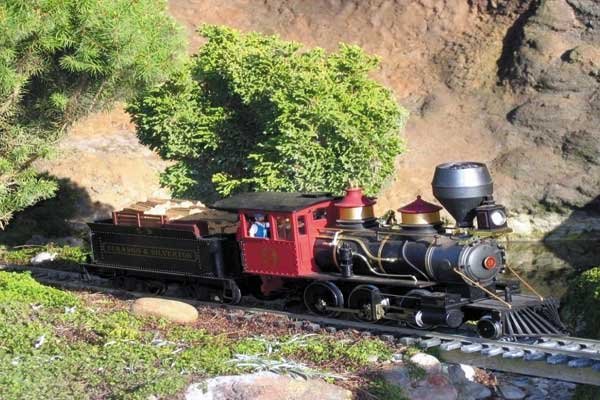By day, he runs his own company as an environmental contractor,
making sure that local fuel tanks don’t leak into ground soil and
that back-up generators for the fire station will have enough ready
fuel. By night (and late afternoons, weekends and holidays), he
enjoys being a garden railroader.
By day, he runs his own company as an environmental contractor, making sure that local fuel tanks don’t leak into ground soil and that back-up generators for the fire station will have enough ready fuel. By night (and late afternoons, weekends and holidays), he enjoys being a garden railroader.
“Well, we like being outside,” Dale McAnally said, as he and his wife Pat gave me a tour of their garden in northeast Gilroy, replete with mountains, miniature live trees and 350 feet of train tracks. “I was going to be out here anyway, so I might as well be doing something fun.”
Worldwide, garden railroading is a popular hobby which combines building actual working model trains with outdoor settings created by using slow-growing dwarf trees, plants, ponds and waterfalls.
McAnally tried vegetable gardening, but constructing elaborate tunnels for train tracks to run through and setting up an actual smoking volcano (using rock concert technology) proved to be more exciting.
“It’s limited only by your imagination. I know of one garden railroader who used a small flat screen in his garden to create a working outdoor drive-in movie theater!” he said with so much enthusiasm that for a moment, I was ready to take up garden railroading for myself.
“It’s an excuse to play with toys,” McAnally admitted, as he showed me his workshop, shelves filled with Orchard Supply and Graniterock train car models, his table piled with mounds of toy animals. “This is one of the most popular items with kids,” he said, showing me a real working old west gallows with a hangman. Another shelf held buildings made by McAnally, including an 1889 dentistry office painted green and white and a saloon with red and yellow trim.
“What is it that really ties all of you garden railroaders together?” I asked McAnally.
“We’re nice people,” he quickly answered. “What I mean is that this hobby naturally attracts a certain kind of person. We exchange ideas and help new people who are just getting started. It’s a team effort.
A lot of husbands and wives work together. Every garden railroader needs help at one time or another. For instance, to put on the upcoming Aug. 9 railroad tour through some of the most unusual backyard gardens from Morgan Hill to Hollister, at least 40 people will be needed for nine open houses. Not all of those 40 will be folks with their own garden railroads. Some are retired garden railroaders living in senior housing that doesn’t allow for them to have their own gardens anymore. This way they can still keep involved.”
Further evidence of the caring attitude of garden railroaders is that the entrance fee for the garden railroad tour is a donation of canned goods or money to St. Joseph’s Family Center and the Community Pantry to feed families in need.
“Everybody has derailments at one time or another, and it takes more than one person to fix problems like that,” he said. “The main tie of railroads are the good memories they bring back and the way everybody helps everybody.”
The tour is an economical local outing, with lunch being offered for $3 to $5.
“For a non-perishable canned or packaged food donation, you can entertain your family and have a great day together,” McAnally pointed out. “There’s one little boy interested in trains whose dad has brought him on the tour every year for 12 years now.”
Bring a canned good, pasta, or cereal donation and pick up a guide book at the All Aboard Junction train store at 8355 Monterey St. (behind Cottage Floors). Call Pat (846-8841) or Dale (848-1440) for more info.













